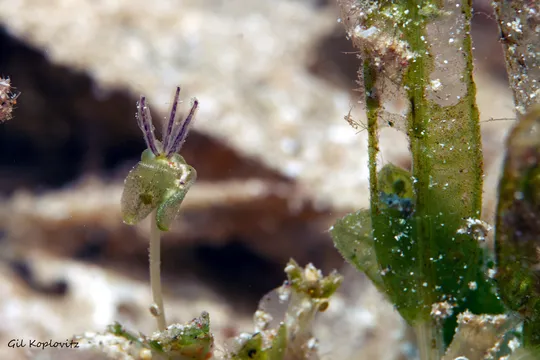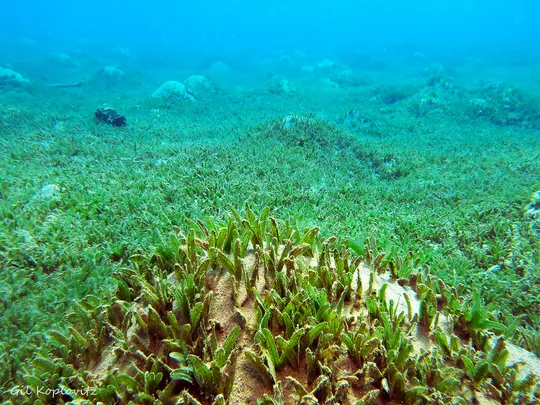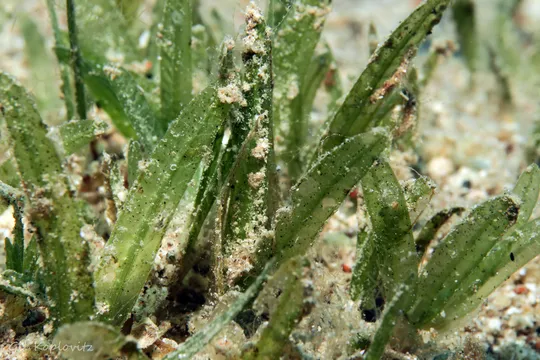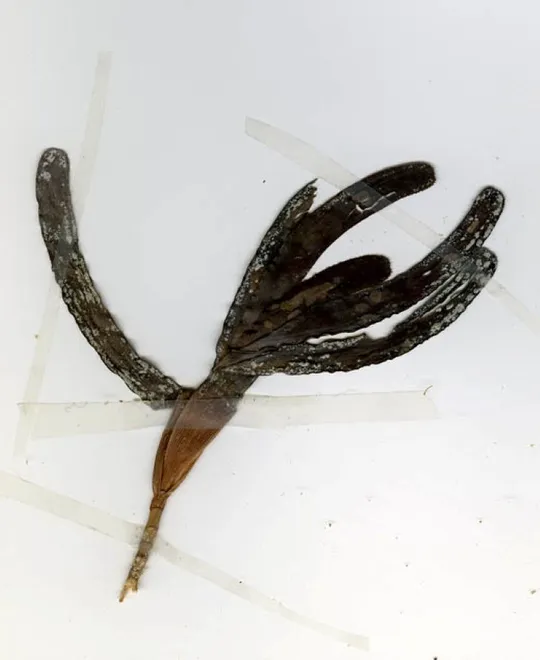Halophila stipulacea




Halophila stipulacea
grows in the Gulf of Elat, near the coast. The following populations are currently
known from the Israeli coastal section: a. On the Northern Beach (also spreads to
the Jordanian beach) – this population is given to fluctuations, and is
apparently declining in recent years. b. A few patches near the port and naval
base. c. Near the oil port and d. Large, well-developed populations south of
the marine research laboratory to the Egyptian border (Lipkin et al., 2003, and
Jacob Dafni and Dudu Zakay, pers. comm.).
Halophila stipulacea
grows in seawater in the intertidal zone of tropical seas in a wide range of depths,
from the lower intertidal zone to a depth of 70 m. It occasionally appears in reef
areas that are exposed at low tide. It grows on varied substrates such as calcareous
sand, coarse sand and clay. It can tolerate a broad range of salinity,
temperatures and oxygen and carbon dioxide concentrations in the water. In the Gulf
of Elat it dominates and occasionally is the only species in plant communities
forming dense grassy “cushions” in shallow water and at greater depths.
See Halophila ovalis.
·
The
Halophila
stipulacea populations are vulnerable due to the
degradation of the reefs in the Israeli section of the Gulf of Elat. The number
of populations and the size of the colonies is constantly decreasing. The
population of the north coast has been particularly affected since the early 1990s
because of pollution from caged fish farming.
·
The
deteriorating habitat quality led to the shrinking and disappearance of shallow
water populations leaving mainly deep-water populations.
·
H. stipulacea is protected by law and grows in the Coral Beach Nature
Reserve. Is not globally endangered.
Water quality should be preserved and pollution prevented
in general. The natural habitats in the Israeli section of the Gulf of Elat should
be preserved and rehabilitated.
Halophila stipulacea
has a broad tropical distribution: it grows in the Red Sea on the coast of
Egypt, Sudan, Eritrea and the Arabian Peninsula. According to Lipkin (Lipkin et
al., 2003), it is more common in the northern part of the Red Sea, and less
common in the central and southern part. It is broadly distributed throughout the
East African and Indian Ocean coasts, east to the coasts of Malaysia and Indonesia.
On the Sinai coast is also very common in the Gulf of Elat
and the Gulf of Suez. The opening of the Suez Canal in 1869 allowed H.
stipulacea to reach the Mediterranean Sea (Lessepsian migration).
This is the first species of the tropical sea grasses that migrated to the
Mediterranean, probably through the movement of ships from Port Said northwards
and westwards. Today it is found on Middle Eastern beaches in Cyprus, the
Aegean Islands, on the coast of Egypt, and its range extends westwards to
Malta. It is absent from the Mediterranean coast in northern Sinai, Israel and
Lebanon.
Halophila
stipulacea is a submersed sea grass that grows in
the Gulf of Elat coast in Israel. The number of H.
stipulacea sites is small as the coast of the Gulf of Elat within
Israel is only 10.5 km long. Hence, despite being a common species in the entire
Gulf of Elat, from the Israeli perspective it is a rare species. The continued degradation
of the beaches in the Israeli section of the Gulf of Elat because of
development, construction and pollution, threatens the existence of its populations.
On the basis of these considerations the plant was given the status of a red
species, in the threatened species category.
ראה ימון ביצני.
Current Occupancy Map
| 1000 squre meter pixel | 5000 squre meter pixel | 10000 squre meter pixel | |
|---|---|---|---|
| number of observations | 0 | 0 | 0 |
| in total pixels | 0 | 0 | 0 |
| Family | Hydrocharitaceae |
| Classification | On the endangered species list |
| Ecosystem | Red Sea |
| Chorotype | Tropical |
| Conservation Site | On the coast South of the Marine Research Laboratory in Elat |
| Rarity |
1
3
6
|
|---|---|
| Vulnerability |
0
4
4
|
| Attractiveness |
0
0
4
|
| Endemism |
0
0
4
|
| Red number |
1
3.7
10
|
| Peripherality | 0 |
| IUCN category | DD EW EX LC CR EN VU NT |
| Threat Definition according to the red book | Vulnerable |
 Based on:
Based on:






